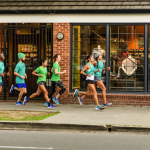Russell Corporation reported that fiscal third quarter 2005 earnings fell 41.5% to $15.8 million, or 47 cents per diluted share, comapared to $26.9 million, or 82 cents per diluted share, in the year-ago period. Sales for the quarter were $424.6 million versus last year's $422.7 million in revenues.
Operating income was $33.9 million in the quarter, down from last year's $44.0 million, as operational issues disclosed in the second quarter were exacerbated by Hurricanes Katrina and Rita. In addition to the previously announced impact of the elimination of the COO position in the third quarter of approximately six cents per share, RML experienced significant economic losses attributed to the storms. The company estimates the equivalent of five cents per share of lost earnings associated with missed sales due to the hurricanes plus additional direct costs of $two cents per share in the third quarter.
Excluding the impact of the hurricanes and the elimination of the COO position in the quarter, earnings would have been approximately 60 cents per share, at the top end of the range previously provided by the company. This compares with third quarter 2004 earnings per share of 82 cents on a fully diluted basis, which included a 13 cents benefit from a favorable tax adjustment.
Russell achieved results at the top end of range versus earlier projections due to lower than expected costs in Activewear and strong sales and profit improvements in international apparel, which were partially offset by losses at Huffy Sports.
Russell said it was on track to have the previously announced operational issues resolved by the end of the year. Significant improvements have been made in sewing efficiencies in offshore plants while reducing manufacturing variances associated with the ramp up of production within textile operations in Alexander City, Alabama.
According to Jack Ward, chairman and CEO, “We have made significant progress in fixing our short term issues, despite major disruptions due to the recent hurricanes. Having addressed these short term issues, we can now concentrate on building our businesses for the long term.”
As reported earlier, RML lost more than 40 containers of product from Katrina, as the Company's primary ports of entry for the export of components (fabric and cut parts) and the import of finished goods were damaged in the storm. Shipping has now returned to more normal levels with the reopening of Gulfport, Mississippi, and the shift of certain shipments through Panama City, Florida.
Due to the effects of Katrina, fiber manufacturers increased prices as much as 20 percent. With Russell's traditional strength in poly/cotton blends, higher staple costs are expected to continue to impact the Company's financial results temporarily, but should “normalize,” albeit at a higher level, when world supplies are increased, as expected.
With aggressive actions, the estimated losses associated with the hurricanes have been reduced to a range of $0.13 to $0.16 on a per share basis. The Company does expect to recover a significant portion of these extra expenses from its insurance carriers.
Segment Sales
Sales in the Sporting Goods segment increased by five percent, or nearly $10 million, with sales from acquisitions owned for less than a year contributing approximately $33 million. Continued strength in Dri-POWER(R) performance products for the Russell Athletic Group partially offset declines due to product availability. Sales in the Spalding Group were down slightly from prior year, while Brooks continued to perform exceptionally well, contributing nearly $32 million in revenues in the quarter and achieving its profit plan.
Excluding acquisitions, sales in the Sporting Goods division declined 12.2% for the period.
In the Activewear segment, demand remained strong for JERZEES(R) products in the Artwear channel, offsetting declines in the Retail channel, which were primarily due to retail inventory adjustments.
Outlook
The Company is reaffirming its earnings projections for the full year, and expects fiscal 2005 sales in the $1.45 billion to $1.46 billion range with earnings on a per share basis (excluding the COO position elimination, the impact of the hurricanes, and other potential special charges) in the $1.25 to $1.35 range.
The Company is anticipating solid sales increases in most of its businesses next year, which should more than offset the recent Wal-Mart decision to replace the JERZEES(R) brand of boys' sweatshirts and sweatpants for fall 2006. Additionally, expected operational improvements, a full year of the Honduran plant and selective price increases, should offset inflationary trends currently being experienced.
Russell is forecasting solid spring business with a number of new products and an expanded presence at retail. Russell Athletic continues to expand its floor space at retail with product line extensions and increased visibility with a new point of sale presence in sporting goods chains. Likewise, Spalding's latest innovation, the new NeverFlat(TM) basketball, has recently been introduced and is being well received by sporting good retailers. This premium priced NeverFlat(TM) basketball holds its pressure ten times longer than an ordinary basketball, and is expected to be on retail shelves this winter. Also, in the Sporting Goods segment, Brooks continues to meet or exceed expectations, with bookings for spring 2006 currently up more than 30 percent. Brooks is experiencing increased demand from national sporting goods accounts in addition to its primary market, specialty running retailers, where Brooks is one of the largest share brands.
Ward added, “We feel positive about our long-term potential. We continue to believe in our strategy to become a premier sporting goods company, as demonstrated by our stable of consumer brands built on a heritage of quality athletic products.”















